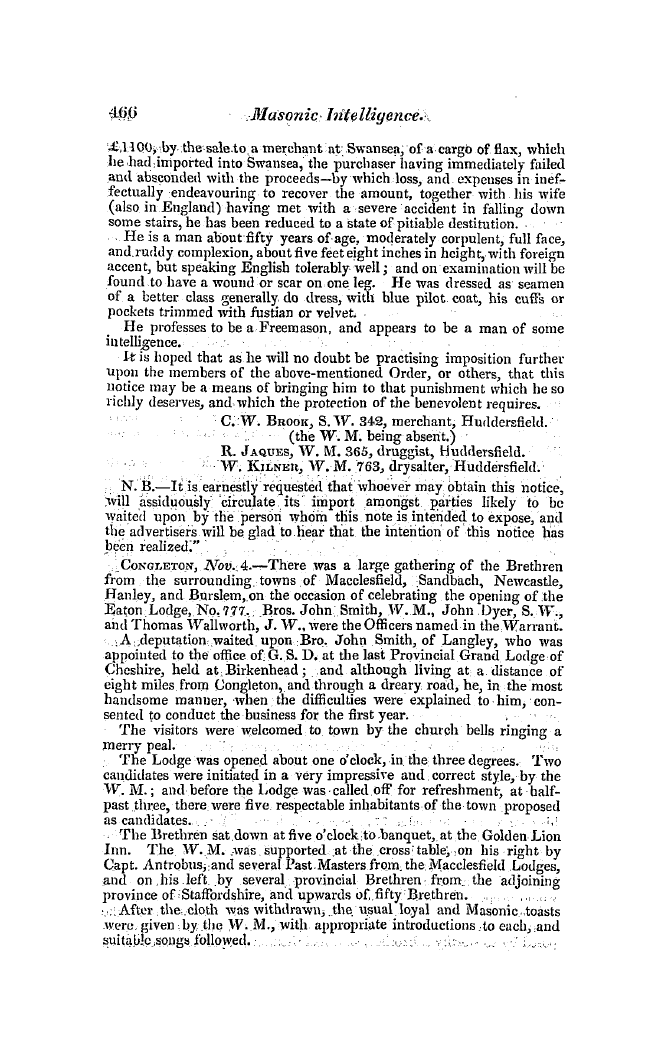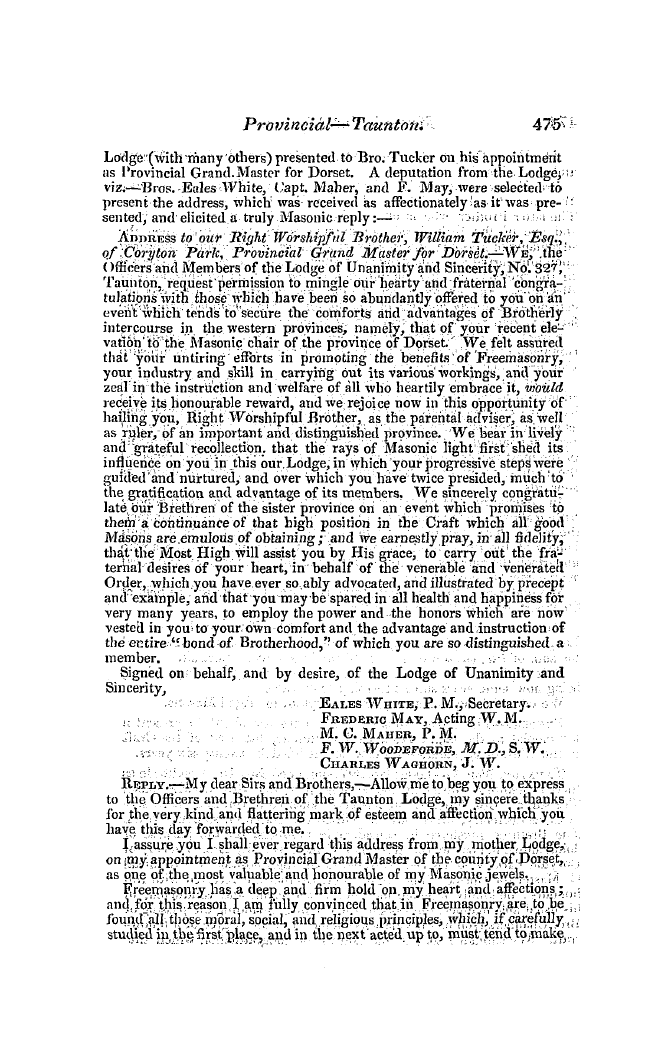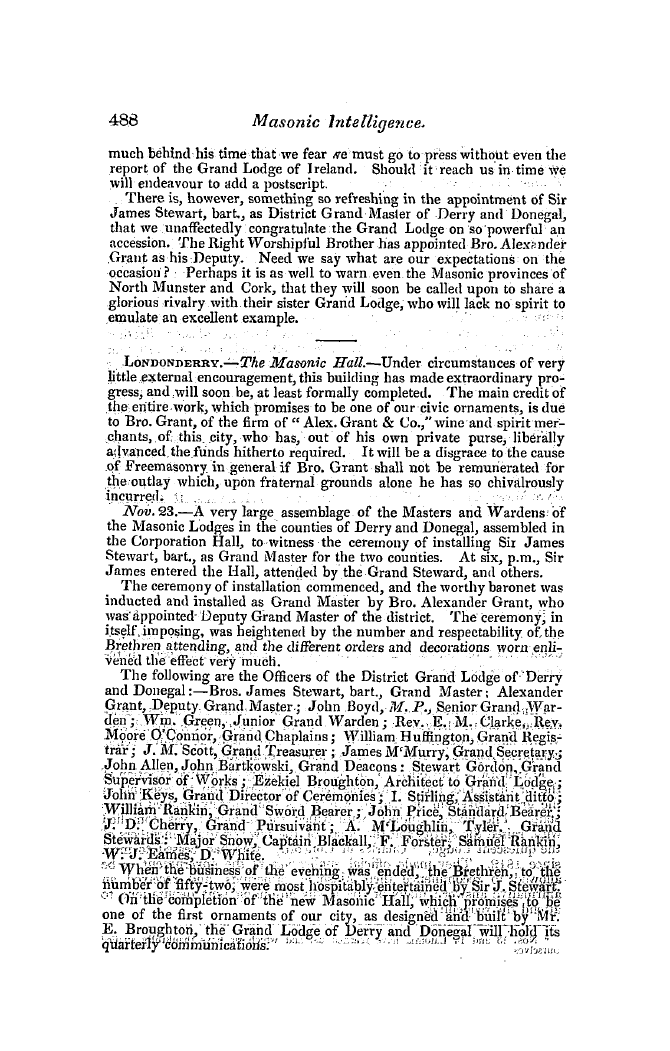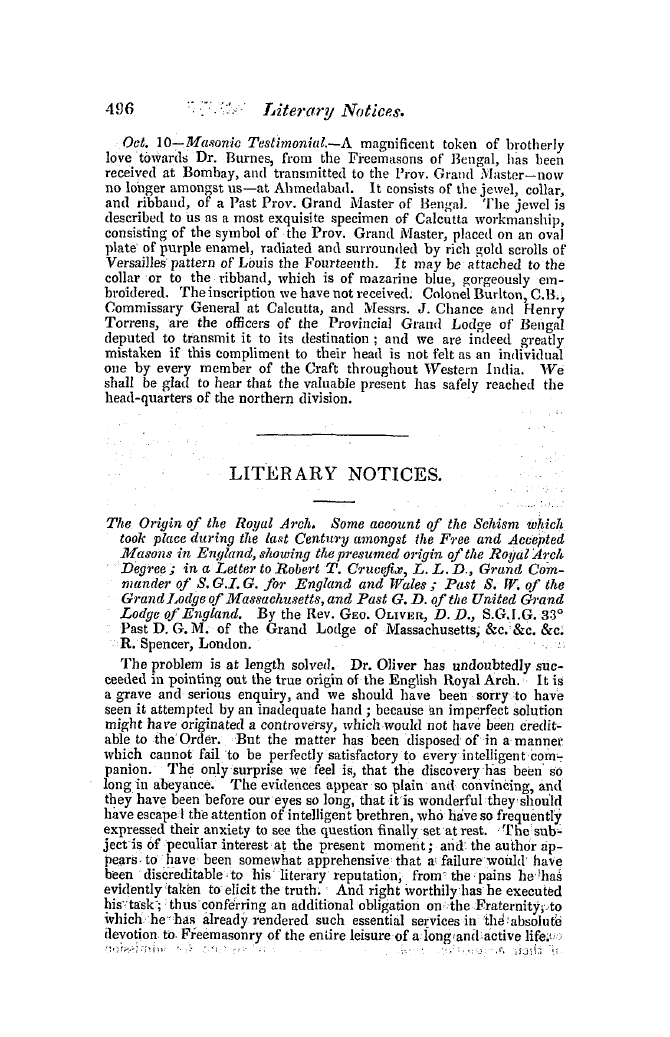-
Articles/Ads
Article ON THE VITRIFIED FORTS IN NORTH BRITAIN. ← Page 2 of 5 →
Note: This text has been automatically extracted via Optical Character Recognition (OCR) software.
On The Vitrified Forts In North Britain.
course , being somewhat elevated above the present surface ofthe ground ; the whole , however , are covered with a thick coating of moss , heather , and grass . Bro . Jeffkins and myself having removed this covering in several places , laid considerable portions of the walls bare , so as to be enabled to examine their structure . There were no traces whatever
ot any wrought stones , but all were rough and unhewn ; neither was there the slightest indication of any kind of cement ; but the stones , which were of various kinds and irregular sizes , were connected together by a matter or substance in some places resembling lava , but generally more like the scoria ? of a foundry . In some instances the stones were firmly united like bricks improperly burnt and fused together in a kiln ; others were loose , and could be detached from the mass as easily as from a heap of cinders . The whole of the stones had been softened and
partially melted by fire ; and it was evident that the entire structure had been subjected to the influence of intense heat , so great indeed as to change the character of every stone of which it was originally composed . The rock on which the fort stands is new red sandstone , but the stones employed in the structure are of different descriptions ; pieces of mica , granite , slate , and limestone being perceptible . I detached several specimens of these various kinds of stone ; in all the powerful action of
fire is distinctly manifested . These specimens were taken in various places from the sides of the fort and from masses of similar character . It is evident that the walls of the fort when perfect , were entirely vitrified , and that subsequent violence , assisted by the corroding effect of the atmosphere operating through numerous ages , has in many places destroyed the original adhesive power , and occasioned the desintegratioh of the component masses ; thus accounting for the loose and crumbling
appearance they now assume . I may here remark that on the outside of the parallelogram I have described , there is an appearance of a second rampart , but not so distinct as the other .
Of these forts , so singular in their character , no specimen whatever exists in South Britain ; and the only ' analogous buildings , so far as the peculiar mode of construction is concerned , seem to be some remains of the most remote antiquity in the vicinity of ancient Babylon and on thc plains of Shinar . Some structures have indeed been recently discovered in France in which fire has been evidently used in their formation ; but theseas I shall hereafter take occasion to remarkare not
, , strictly analagous , nor of equal antiquity . From the minute and careful inspection which I made of the fort on Craig Phadric , I am clearly of opinion that the stones were collected and placed together in due form , without tooling , and without cement , and that afterwards the entire structure was . vitrified , or run together , by the application of heat . Now , on taking several portions of rock
similar in description to those employed in the construction of this fort , and subjecting them to the influence of heat , applied in the ordinary manner , no effect whatever was produced . It became , therefore , evident that the vitrification in question could not have resulted from any ordinary fire , but must have been effected by the constructors of the fort , for the purpose of connecting their work together ; and this was no doubt accomplished by means of an alkali mixed with wood ; for although ordinary heat will not produce the result described , the application of an alkali during the fusion , will occasion a flux of the silicious particles , and operate upon stones in precisely the same way as the materials em-
Note: This text has been automatically extracted via Optical Character Recognition (OCR) software.
On The Vitrified Forts In North Britain.
course , being somewhat elevated above the present surface ofthe ground ; the whole , however , are covered with a thick coating of moss , heather , and grass . Bro . Jeffkins and myself having removed this covering in several places , laid considerable portions of the walls bare , so as to be enabled to examine their structure . There were no traces whatever
ot any wrought stones , but all were rough and unhewn ; neither was there the slightest indication of any kind of cement ; but the stones , which were of various kinds and irregular sizes , were connected together by a matter or substance in some places resembling lava , but generally more like the scoria ? of a foundry . In some instances the stones were firmly united like bricks improperly burnt and fused together in a kiln ; others were loose , and could be detached from the mass as easily as from a heap of cinders . The whole of the stones had been softened and
partially melted by fire ; and it was evident that the entire structure had been subjected to the influence of intense heat , so great indeed as to change the character of every stone of which it was originally composed . The rock on which the fort stands is new red sandstone , but the stones employed in the structure are of different descriptions ; pieces of mica , granite , slate , and limestone being perceptible . I detached several specimens of these various kinds of stone ; in all the powerful action of
fire is distinctly manifested . These specimens were taken in various places from the sides of the fort and from masses of similar character . It is evident that the walls of the fort when perfect , were entirely vitrified , and that subsequent violence , assisted by the corroding effect of the atmosphere operating through numerous ages , has in many places destroyed the original adhesive power , and occasioned the desintegratioh of the component masses ; thus accounting for the loose and crumbling
appearance they now assume . I may here remark that on the outside of the parallelogram I have described , there is an appearance of a second rampart , but not so distinct as the other .
Of these forts , so singular in their character , no specimen whatever exists in South Britain ; and the only ' analogous buildings , so far as the peculiar mode of construction is concerned , seem to be some remains of the most remote antiquity in the vicinity of ancient Babylon and on thc plains of Shinar . Some structures have indeed been recently discovered in France in which fire has been evidently used in their formation ; but theseas I shall hereafter take occasion to remarkare not
, , strictly analagous , nor of equal antiquity . From the minute and careful inspection which I made of the fort on Craig Phadric , I am clearly of opinion that the stones were collected and placed together in due form , without tooling , and without cement , and that afterwards the entire structure was . vitrified , or run together , by the application of heat . Now , on taking several portions of rock
similar in description to those employed in the construction of this fort , and subjecting them to the influence of heat , applied in the ordinary manner , no effect whatever was produced . It became , therefore , evident that the vitrification in question could not have resulted from any ordinary fire , but must have been effected by the constructors of the fort , for the purpose of connecting their work together ; and this was no doubt accomplished by means of an alkali mixed with wood ; for although ordinary heat will not produce the result described , the application of an alkali during the fusion , will occasion a flux of the silicious particles , and operate upon stones in precisely the same way as the materials em-

































































































































